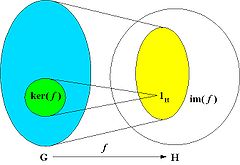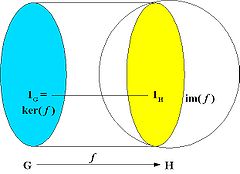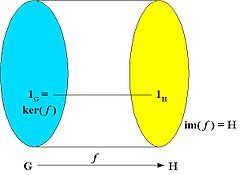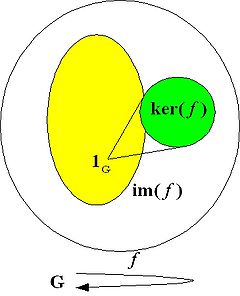Difference between revisions of "Group homomorphism"
From Online Dictionary of Crystallography
(definition of a group replaced by a link to a separate definition) |
BrianMcMahon (talk | contribs) m |
||
| Line 1: | Line 1: | ||
<font color="blue">Homomorphisme de groupes </font> (''Fr''). <font color="red">Gruppenhomomorphismus</font> (''Ge''). <font color="green">Homomorfismo de grupos </font> (''Sp''). <font color="black">Omomorfismo di gruppi </font> (''It''). <Font color="purple">準同形</font> (''Ja''). | <font color="blue">Homomorphisme de groupes </font> (''Fr''). <font color="red">Gruppenhomomorphismus</font> (''Ge''). <font color="green">Homomorfismo de grupos </font> (''Sp''). <font color="black">Omomorfismo di gruppi </font> (''It''). <Font color="purple">準同形</font> (''Ja''). | ||
| + | |||
==Homomorphism between groups== | ==Homomorphism between groups== | ||
| + | |||
A '''group homomorphism''' from a [[group]] (''G'', *) to a [[group]] (''H'', #) is a [[mapping]] ''f'' : ''G'' → ''H'' that preserves the composition law, i.e. for all ''u'' and ''v'' in ''G'' one has: | A '''group homomorphism''' from a [[group]] (''G'', *) to a [[group]] (''H'', #) is a [[mapping]] ''f'' : ''G'' → ''H'' that preserves the composition law, i.e. for all ''u'' and ''v'' in ''G'' one has: | ||
<div align="center"> | <div align="center"> | ||
| Line 10: | Line 12: | ||
A homomorphism ''f'' maps the identity element 1<sub>''G''</sub> of ''G'' to the identity element 1<sub>''H''</sub> of ''H'', and it also maps inverses to inverses: ''f''(''u''<sup>-1</sup>) = ''f''(''u'')<sup>-1</sup>. | A homomorphism ''f'' maps the identity element 1<sub>''G''</sub> of ''G'' to the identity element 1<sub>''H''</sub> of ''H'', and it also maps inverses to inverses: ''f''(''u''<sup>-1</sup>) = ''f''(''u'')<sup>-1</sup>. | ||
| + | |||
== Kernel and image== | == Kernel and image== | ||
| − | [[Image:Homomorphism.jpg|thumb| | + | [[Image:Homomorphism.jpg|thumb|240px|'''Group homomorphism'''. The kernel of the homomorphism, ker( ''f'' ) is the set of elements of ''G'' that are mapped to the identity element of ''H''. The image of the homomorphism, im( ''f'' ), is the set of elements of ''H'' to which at least one element of ''G'' is mapped. im( ''f'' ) is not required to be the whole of ''H'']] |
| + | |||
The ''kernel'' of the homomorphism ''f'' is the set of elements of ''G'' that are [[mapping|mapped]] to the identity of ''H'': | The ''kernel'' of the homomorphism ''f'' is the set of elements of ''G'' that are [[mapping|mapped]] to the identity of ''H'': | ||
<div align="center"> | <div align="center"> | ||
| Line 25: | Line 29: | ||
The kernel is a [[normal subgroup]] of ''G'' and the image is a [[subgroup]] of ''H''. | The kernel is a [[normal subgroup]] of ''G'' and the image is a [[subgroup]] of ''H''. | ||
| + | |||
== Types of homomorphisms == | == Types of homomorphisms == | ||
| Line 32: | Line 37: | ||
===Surjective, injective and bijective homomorphisms=== | ===Surjective, injective and bijective homomorphisms=== | ||
| − | [[Image:Epimorphism.jpg|thumb| | + | [[Image:Epimorphism.jpg|thumb|240px|An '''epimorphism''' is a surjective homomorphism, i.e. a homomorphism such that the image is the entire [[Mapping|codomain]]]] |
| + | |||
An '''epimorphism''' is a [[mapping|surjective]] homomorphism, that is, a homomorphism which is ''onto'' as a mapping. The image of the homomorphism is the whole of ''H'', i.e. im( ''f'' ) = ''H'' | An '''epimorphism''' is a [[mapping|surjective]] homomorphism, that is, a homomorphism which is ''onto'' as a mapping. The image of the homomorphism is the whole of ''H'', i.e. im( ''f'' ) = ''H'' | ||
| − | [[Image:Monomorphism.jpg|thumb| | + | [[Image:Monomorphism.jpg|thumb|240px|A '''monomorphism''' is an injective homomorphism, i.e. a homomorphism where different elements of ''G'' are mapped to different elements of ''H'']] |
A '''monomorphism''' is an [[mapping|injective]] homomorphism, that is, a homomorphism which is ''one-to-one'' as a mapping. In this case, ker( ''f'' ) = {1<sub>''G''</sub> }. | A '''monomorphism''' is an [[mapping|injective]] homomorphism, that is, a homomorphism which is ''one-to-one'' as a mapping. In this case, ker( ''f'' ) = {1<sub>''G''</sub> }. | ||
| − | [[Image:Isomorphism.jpg|thumb| | + | [[Image:Isomorphism.jpg|thumb|240px|An '''isomorphism''' is a bijective homomorphism, i.e. it is a one-to-one correspondence between the elements of ''G'' and those of ''H''. Isomorphic groups (''G'',*) and (''H'',#) differ only in the notation of their elements and binary operations]] |
| + | |||
If the homomorphism ''f'' is a [[mapping|bijection]], then its inverse is also a group homomorphism, and ''f'' is called an '''[[group isomorphism| isomorphism]]'''; the groups (''G'',*) and (''H'',#) are called ''isomorphic'' and differ only in the notation of their elements (and possibly their binary operations), while they can be regarded as identical for most practical purposes. | If the homomorphism ''f'' is a [[mapping|bijection]], then its inverse is also a group homomorphism, and ''f'' is called an '''[[group isomorphism| isomorphism]]'''; the groups (''G'',*) and (''H'',#) are called ''isomorphic'' and differ only in the notation of their elements (and possibly their binary operations), while they can be regarded as identical for most practical purposes. | ||
| + | |||
===Homomorphisms from a group to itself (G = H)=== | ===Homomorphisms from a group to itself (G = H)=== | ||
| − | [[Image:Endomorphism.jpg|thumb| | + | [[Image:Endomorphism.jpg|thumb|240px|An '''endomorphism''' is homomorphism of ''G'' to itself]] |
| + | |||
An '''endomorphism''' is a homomorphism of a group to itself: ''f'': ''G'' → ''G''. | An '''endomorphism''' is a homomorphism of a group to itself: ''f'': ''G'' → ''G''. | ||
| − | |||
A [[mapping|bijective]] (invertible) endomorphism (which is hence an [[group isomorphism| isomorphism]]) is called an '''[[automorphism]]'''. The kernel of the automorphism is the identity of ''G'' (1<sub>G</sub>) and the image of the automorphism coincides with ''G''. The set of all automorphisms of a group (''G'',*) forms itself a group, the ''automorphism group'' of ''G'', '''Aut(''G'')'''. | A [[mapping|bijective]] (invertible) endomorphism (which is hence an [[group isomorphism| isomorphism]]) is called an '''[[automorphism]]'''. The kernel of the automorphism is the identity of ''G'' (1<sub>G</sub>) and the image of the automorphism coincides with ''G''. The set of all automorphisms of a group (''G'',*) forms itself a group, the ''automorphism group'' of ''G'', '''Aut(''G'')'''. | ||
[[Category:Fundamental crystallography]] | [[Category:Fundamental crystallography]] | ||
Revision as of 13:30, 6 February 2012
Homomorphisme de groupes (Fr). Gruppenhomomorphismus (Ge). Homomorfismo de grupos (Sp). Omomorfismo di gruppi (It). 準同形 (Ja).
Contents
[hide]Homomorphism between groups
A group homomorphism from a group (G, *) to a group (H, #) is a mapping f : G → H that preserves the composition law, i.e. for all u and v in G one has:
f(u * v) = f(u) # f(v).
A homomorphism f maps the identity element 1G of G to the identity element 1H of H, and it also maps inverses to inverses: f(u-1) = f(u)-1.
Kernel and image
The kernel of the homomorphism f is the set of elements of G that are mapped to the identity of H:
ker( f ) = { u in G : f(u) = 1H }
The image of the homomorphism f is the subset of elements of H to which at least one element of G is mapped by f:
im( f ) = { f(u) : u in G }.
The kernel is a normal subgroup of G and the image is a subgroup of H.
Types of homomorphisms
Homomorphisms can be classified according to different criteria, among which the relation between G and H and the nature of the mapping.
Surjective, injective and bijective homomorphisms

An epimorphism is a surjective homomorphism, that is, a homomorphism which is onto as a mapping. The image of the homomorphism is the whole of H, i.e. im( f ) = H
A monomorphism is an injective homomorphism, that is, a homomorphism which is one-to-one as a mapping. In this case, ker( f ) = {1G }.
If the homomorphism f is a bijection, then its inverse is also a group homomorphism, and f is called an isomorphism; the groups (G,*) and (H,#) are called isomorphic and differ only in the notation of their elements (and possibly their binary operations), while they can be regarded as identical for most practical purposes.
Homomorphisms from a group to itself (G = H)
An endomorphism is a homomorphism of a group to itself: f: G → G.
A bijective (invertible) endomorphism (which is hence an isomorphism) is called an automorphism. The kernel of the automorphism is the identity of G (1G) and the image of the automorphism coincides with G. The set of all automorphisms of a group (G,*) forms itself a group, the automorphism group of G, Aut(G).



